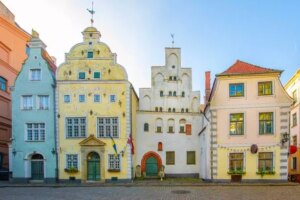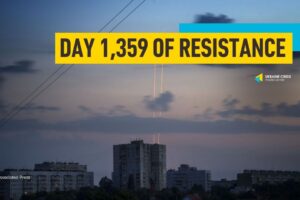
Some two years ago, municipalities across Germany sounded the alarm, reporting that many places simply could not cope with the influx of refugees, in particular from Ukraine. The German Association of Towns and Municipalities called for the curbing of migration.
“Emergency mode” has become a term frequently used to describe the situation of overstretched cities and municipalities — a topic that has steadfastly remained in the news.
A survey of almost 900 municipalities now shows some improvement. “The proportion of municipalities that see themselves in emergency mode and describe themselves as overburdened has visibly decreased to 11%,” said Boris Kühn from the Migration Policy Research Group at the University of Hildesheim.
“At the same time, however, more than 70% of municipalities continue to say that the situation is challenging. It would therefore not be accurate to talk about a relaxed situation across the board,” he added.
Number of asylum applications in Germany falls
The improvement is mainly due to the drop in the number of arrivals. Since the autumn of 2023, the number of people applying for asylum in Germany has fallen significantly.
In 2023, 330,000 applications were made. A year later, there were 230,000 first-time applications. And in 2025, this had dropped to around 97,000 people.
“Just under 50 percent of local authorities say that the accommodation situation has improved in the past year — all federal states are seeing a similar trend, ” says Kühn.
However, Klaus Ritgen from the German County Association (DLT) warned it would be wrong to draw the conclusion that everything is now fine at the municipal level. He said that more than 4 million people had fled to Germany over the past decade: 1.3 million people fleeing the war in Ukraine, as well as refugees from other countries. Many have no economic prospects, added Ritgen.
“If we want to talk about an easing of the situation, the category ‘challenging’ should no longer even exist. The falling number of refugees is giving local authorities some much-needed breathing space for the time being.” According to Ritgen, it would be absolutely erroneous to conclude from survey results that municipalities are now ready to take in a new, larger number of refugees again. “In our view, we have reached the limit of our capacity to accept and integrate refugees.”
Immigration authorities are especially overstretched
A major problem remains that the municipalities in Germany are not getting sufficient financial support from the federal and state governments for the integration of refugees. Municipal debt will amount to €170 billion ($197 bn) in 2024, according to the Federal Statistical Office. One district county in the western state of Rhineland-Palatinate responded in the study that municipalities were having to cut some services that were vital for the integration of people because they had so many other things to pay for from their budget.
The budgetary and staffing resources of immigration authorities, in particular, remain a huge problem: “Sixty percent of major cities say that our immigration authorities are in emergency mode, and that affects a correspondingly large number of people,” said migration expert Boris Kühn.
In contrast, the outlook for daycare centers is encouraging, according to Kühn. In the last survey, 44% of local authorities reported that they were in emergency mode. Now this figure is just over 20 percent.
Ukrainians waiting for apartments
Miriam Koch has a lot of insight into how local authorities have mastered the integration of refugees over the past ten years. She was the city of Düsseldorf’s first Commissioner for Refugees, then took over the city’s Office for Migration and Integration and has been Head of the Department for Culture and Integration since 2022. The biggest challenge to date has been the large influx of Ukrainians into the city, which has the largest Ukrainian community in North Rhine-Westphalia.
Koch told DW that Düsseldorf is not in crisis mode. But she added: “In 2022, we actually took in as many people from Ukraine within six months as we did in 2015, 2016 and 2017 from all other countries. With people being housed in hotels because they were not yet fully back up and running due to the effects of the COVID pandemic.” She said some 1,700 Ukrainians have still not found their own accommodation and are being housed by the city.
Decentralized accommodation as a recipe for success in integration
Düsseldorf, according to Koch, can still rely on a broad social alliance of associations, churches and charities to help integrate refugees formed in 2015. One lesson from back then: no more large-scale air-inflated emergency shelters. Düsseldorf now sets store by decentralized accommodation for refugees.
The integration expert would like to see more fact-based discussions on the integration of refugees. “The social climate always has a major impact on integration. It annoys me when I hear in the news about the lack of skilled workers and then irregular migration is being defined as the problem of our age in the next report.” Koch said it is important to help people who are already here to integrate and be more attractive to people who want to come. “There really is something very, very paradoxical going on at the moment,” Koch suggested.
This article was originally written in German.
Building new lives in Germany: Volunteers empower migrants
To view this video please enable JavaScript, and consider upgrading to a web browser that supports HTML5 video
While you’re here: Every Tuesday, DW editors round up what is happening in German politics and society. You can sign up here for the weekly email newsletter, Berlin Briefing.





